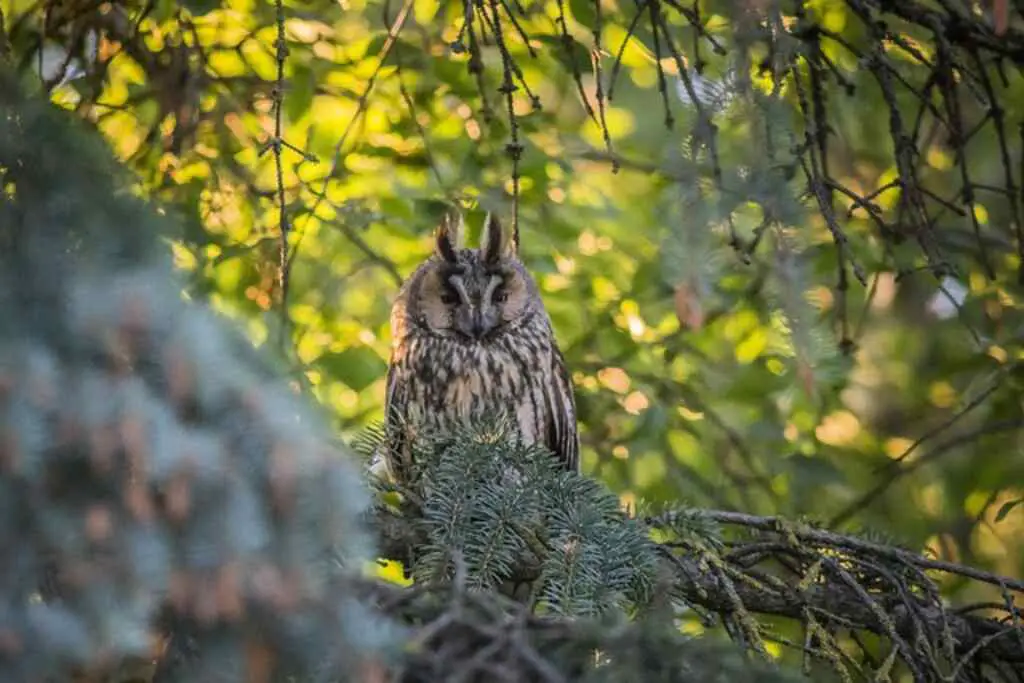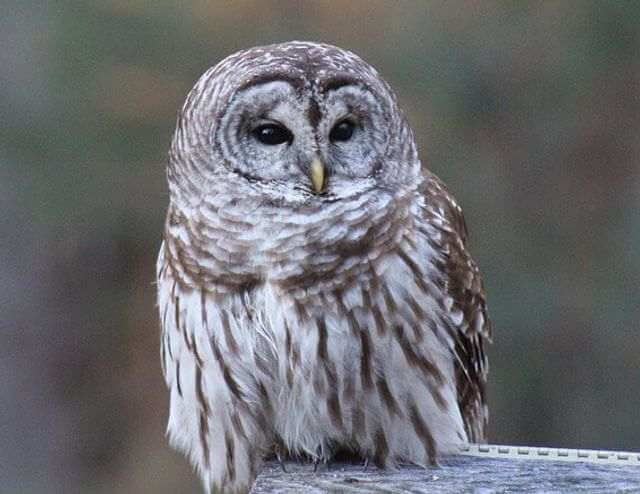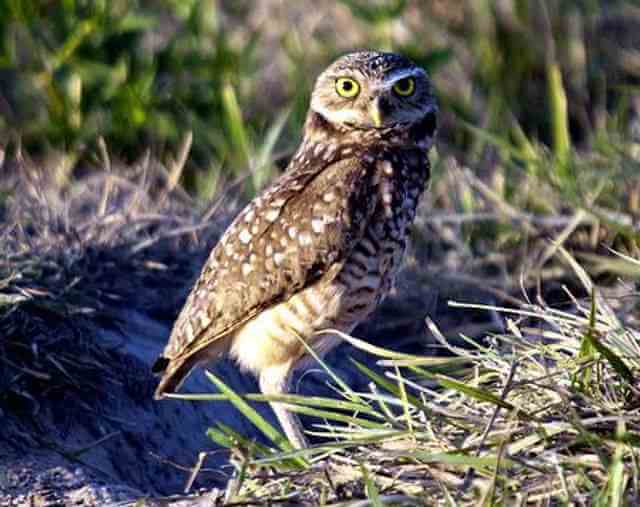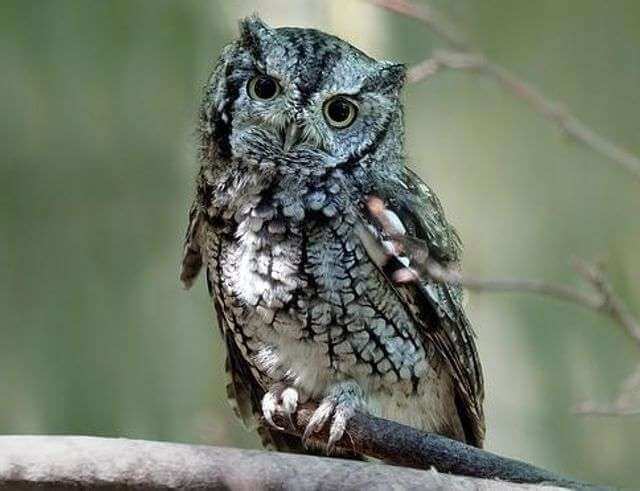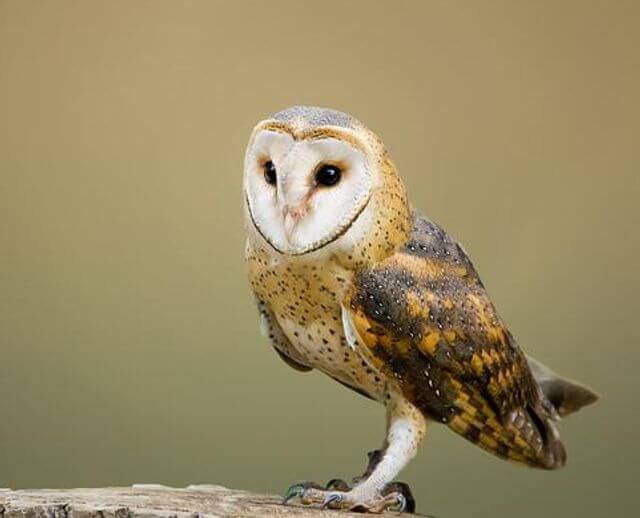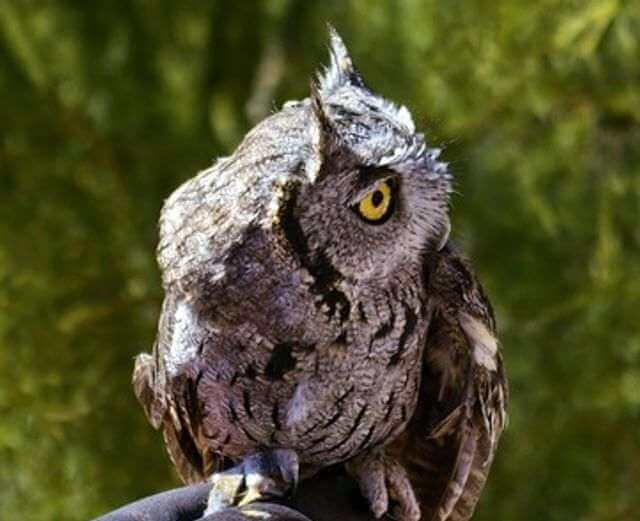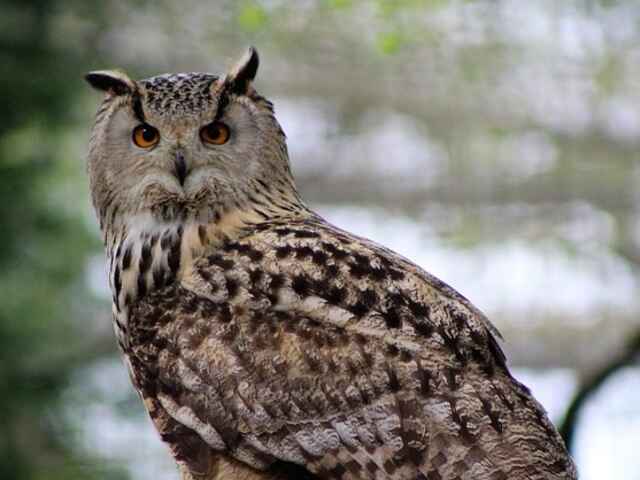Oklahoma’s varied landscapes, from rolling plains to dense forests, provide a rich habitat for a wide range of wildlife. Among the most intriguing creatures that inhabit these diverse ecosystems are the majestic owls.
With their enigmatic presence and silent nocturnal flights, owls are both mysterious and captivating. In this guide, we’ll take you on a journey to discover ten unique types of owls found in Oklahoma, delving into their habitats, behaviors, and the distinctive traits that set each species apart.
Table of Contents
Types of Owls In Oklahoma
Barred Owl
- Length: 16.9-19.7″ in (43-50 cm)
- Weight: 16.6-37.0 oz. (470-1050 g)
- Wingspan: 39.0-43.3″ in (99-110 cm)
- Scientific Name: Strix varia
- Frequency of Occurrence: 2.78% (Statistic by: eBird)
- Maps: Range Map – Sightings Map
- Sounds: Calls
- Where To Find Them: In Oklahoma, they can be found in the eastern part of the state in the Ozark Mountains and in the western part of the state in the Wichita Mountains.
General Information: The Barred Owl is a bird of prey that can be found in North and Central America. It is a large owl, with a body length of 16 to 24 inches and a wingspan of up to 4 feet. The Barred Owl is characterized by its dark brown or gray plumage, with white bars on the chest and belly.
It has large, round eyes, and it sports a hooked beak. These owls are mostly active at night, but can sometimes be seen hunting during daylight hours, too. It hunts small mammals such as mice, voles, and shrews. The Barred Owl nests in tree cavities or old nests of other birds. It usually lays 2 to 5 eggs within a clutch.
Great Horned Owl
- Length: 17.7-24.8 in (45-63 cm)
- Weight: 32.1-88.2 oz. (910-2500 g)
- Wingspan: 39.8-57.1 in (101-145 cm)
- Scientific Name: Bubo virginianus
- Frequency of Occurrence: 2.15%
- Maps: Range Map – Sightings Map
- Sounds: Calls
- Where To Find Them: In Oklahoma, Great Horned Owls are most commonly found in the eastern part of the state, particularly in the Ouachita Mountains. They can also be found in the western Panhandle and in the northern part of the state. Great Horned Owls prefer to nest in trees, but they will also use man-made structures such as buildings and bridges.
General Information: The Great Horned Owl is a large owl with distinctive ear tufts. They are found in woodlands, deserts, and forests across North and South America, and they are one of the most common species of owl in North America. They are also one of the most widespread owls in the world. Great Horned Owls have a large head and body, with a wingspan of up to five feet. They are mostly brown and white, with some variations in coloration.
Great Horned Owls are powerful hunters, preying on small mammals, reptiles, and birds. Great Horned Owls are generally solitary birds, but they may form pairs during breeding season. Breeding usually occurs between December and March. The female lays two to four eggs in a nest made of sticks, leaves, and other materials.
Related: 35 Fun Facts About The Great Horned Owl (Detailed)
Burrowing Owl
- Length: 7.5-9.8″ in (19-25 cm)
- Weight: 5.3 oz. (150 g)
- Wingspan: 21.6″ in (55 cm)
- Scientific Name: Athene cunicularia
- Frequency of Occurrence: 0.2738%
- Maps: Range Map – Sightings Map
- Sounds: Calls
- Where To Find Them: These owls are found in open habitats such as grasslands, deserts, and agricultural fields. In Oklahoma, Burrowing Owls are found throughout the state in these types of habitats. Some of the specific areas where they have been found include the Great Plains, Black Mesa, and Wichita Mountains.
General Information: Burrowing owls are small, long-legged owls found throughout North and South America. These owls get their name from their habit of living in nests dug into by other animals, such as prairie dogs. These owls are mostly nocturnal, but may also hunt during the day. These owls are mostly nocturnal, but can also be seen hunting during the day. Burrowing owls are fairly small owls, with a body length of 7.5-10 inches and a wingspan of 20-24 inches.
They have long legs and a round head with large eyes. Their plumage is generally light brown with white streaks and spots, although it can vary somewhat depending on the subspecies. These owls are particularly active at night, but is also known to hunt during the day. They hunt for a variety of small prey items, including insects, rodents, and lizards.
Related: Really Cool Burrowing Owl Facts That Will Amaze You!
Short-eared Owl
- Length: 13.4-16.9 in (34-43 cm)
- Weight: 7.3-16.8 oz. (206-475 g)
- Wingspan: 33.5-40.5 in (85-103 cm)
- Scientific Name: Asio flammeus
- Frequency of Occurrence: 0.2368%
- Maps: Range Map – Sightings Map
- Sounds: Calls
- Where To Find Them: Short-eared Owls are found in a variety of locations and habitats throughout Oklahoma. They are most commonly found in open grasslands, prairies, and farmland. However, they can also be found in forests, marshes, and even urban areas.
General Information: The Short-eared Owl is a medium sized owl measuring about 13-17 inches in length. They have a wingspan of about 3 feet and weigh between 7-17 ounces. The males and females are similar in appearance with brown and white mottled feathers, long legs, and yellow eyes.
Their name comes from the tiny tufts of feathers on their head that resemble ears. These owls are found in open habitats such as grasslands, marshes, and meadows across North and South America. They are most active at dawn and dusk when they can be seen hunting for small mammals such as voles, lemmings, mice, and shrews.
Eastern Screech Owl
- Length: 6.3-9.8″ in (16-25 cm)
- Weight: 4.3-8.6 oz. (121-244 g)
- Wingspan: 18.9-24.0″ in (48-61 cm)
- Scientific Name: Megascops asio
- Frequency of Occurrence: 0.2318%
- Maps: Range Map – Sightings Map
- Sounds: Calls
- Where To Find Them: One of the best places to find Eastern Screech Owls in Oklahoma is at Lake Thunderbird State Park. The park is located in central Oklahoma, and it is a great place for birdwatching. There are also several other state parks that are good places to see these owls, including Beavers Bend State Park and Keystone State Park.
General Information: The Eastern Screech Owl is a small owl with a large, round head and no ear tufts. Its eyes are bright yellow and its beak is gray. The upperparts are gray or reddish brown with fine streaks, while the underparts are pale with heavy streaks. The wings are short and rounded. The tail is long and square-ended. This owl is found in eastern North America, from southeastern Canada to northern Florida.
It prefers woodlands, but can also be found in suburbs and even cities. It nests in tree cavities, where it lays 3-6 eggs. The diet of the Eastern Screech Owl consists mainly of small mammals such as mice, voles and shrews. It also eats birds, reptiles, amphibians, invertebrates and even fish on occasion.
Barn Owl
- Length: 12.6-15.8″ in (32-40 cm)
- Weight: 14.1-24.7 oz. (400-700 g)
- Wingspan: 39.4-49.2″ in (100-125 cm)
- Scientific Name: Tyto alba
- Frequency of Occurrence: 0.2238%
- Maps: Range Map – Sightings Map
- Sounds: Calls
- Where To Find Them: These owls are quite rare, and can only be found in certain locations. Here are some of the best places to see a Barn Owl in Oklahoma: The Wichita Mountains Wildlife Refuge is one of the best places to see a Barn Owl in Oklahoma. This refuge is home to many different types of animals, including several species of owls. Another great place to see a Barn Owl is at Lake Thunderbird State Park. This park is located in Norman, and is a great spot for birdwatching. Last but not least, another excellent place to view a Barn Owl is at Arrowhead State Park in southeastern Oklahoma.
General Information: The barn owl is a bird that can be found in various locations of the world. They are most commonly found in Western Europe, Central and South Asia, and Africa, but have also been known to inhabit parts of North and South America. The barn owl is a nocturnal creature, which means that it is active during the night. They are known for their distinctive call, which has been described as sounding like a “monkey-like screech”.
The diet of a barn owl consists mostly of small mammals such as mice and voles. If given the opportunity, they will eat any birds, reptiles, or insects. The habitat of a barn owl can vary depending on where they are located geographically. In general, however, they prefer to live in open areas with plenty of trees or other structures to perch on during the day.
Western Screech Owl
- Length: 7.5-9.8 in (19-25 cm)
- Weight: 3.5-10.8 oz. (100-305 g)
- Wingspan: 21.6-24.4 in (55-62 cm)
- Scientific Name: Megascops kennicottii
- Frequency of Occurrence: 0.0474%
- Maps: Range Map – Sightings Map
- Sounds: Calls
- Where To Find Them: The Western Screech Owl is found in a few locations in Oklahoma, but they are quite rare. They are most often found in wooded areas near streams or rivers. They are also sometimes found in open fields or meadows.
General Information: The Western Screech Owl is a small owl with large ear tufts. It is found in western North America from southern Canada to northern Mexico. It has a grey or brown body with white spots and streaks. The underparts are light grey or brown with darker streaks. The wings and tail are dark grey or brown with white bars. The color of its beak is black and its eyes are yellow.
The Western Screech Owl ranges in habitats from forests to deserts to urban areas. It prefers open woodlands, riparian areas, and edges of forests. In the winter, it may be found in evergreen forests at higher elevations. It diet consists mainly of small mammals such as rodents, shrews, and moles. Birds, reptiles, amphibians, and insects are also consumed.
Snowy Owl
- Length: 20.5-27.9 in (52-71 cm)
- Weight: 56.4-104.1 oz. (1600-2950 g)
- Wingspan: 49.6-57.1 in (126-145 cm)
- Scientific Name: Bubo scandiacus
- Frequency of Occurrence: 0.0304%
- Maps: Range Map – Sightings Map
- Sounds: Calls
- Where To Find Them: The Snowy Owl is a beautiful bird that is quite rare in Oklahoma. They are mostly found in the northern part of the state, near the border with Kansas. The best place to see them is in the open areas near lakes and ponds.
General Information: The Snowy Owl is a large bird of prey with white feathers and yellow eyes. It is a native to the Arctic regions of North America, Europe, and Asia. The Snowy Owl is a highly nomadic species, meaning that it does not stick to one specific territory throughout the year. Rather, it will travel considerable distances in search of food sources.
The diet of the Snowy Owl consists mainly of small mammals such as lemmings, voles, and mice. It will also eat birds, reptiles, and insects on occasion. The Snowy Owl has few predators due to its size and powerful hunting ability. However, young owls are sometimes taken by larger raptors such as eagles or hawks.
Related: 48 Fun Facts About Snowy Owls (Full Guide with Photos!)
Long-eared Owl
- Length: 13.8-15.8 in (35-40 cm)
- Weight: 7.8-15.3 oz. (220-435 g)
- Wingspan: 35.4-39.4 in (90-100 cm)
- Scientific Name: Asio otus
- Frequency of Occurrence: 0.0228%
- Maps: Range Map – Sightings Map
- Sounds: Calls
- Where To Find Them: The long-eared owl is a very rare find in Oklahoma. They are mostly found in the eastern part of the state, near the Arkansas border. These owls are also known to inhabit areas along the Red River. If you’re lucky enough to spot one of these elusive creatures, you’ll likely see them roosting in trees or on fence posts.
General Information: The Long-eared Owl is a species of owl which is found in much of the Northern Hemisphere. It is a medium-sized owl, with males being slightly larger than females on average. The plumage of this owl is variable, but it is generally brown or gray in color with some white markings.
The eyes of the Long-eared Owl are large and yellow in color, and it has long ear tufts which give it its name. This owl can be found in a variety of habitats, including forests, woodlands, and even deserts. It typically nests in tree cavities or old nests of other birds. The diet of the Long-eared Owl consists mostly of small mammals such as rodents and shrews.
Northern Saw-whet Owl
- Length: 7.1-8.3 in (18-21 cm)
- Weight: 2.3-5.3 oz. (65-151 g)
- Wingspan: 16.5-18.9 in (42-48 cm)
- Scientific Name: Aegolius acadicus
- Frequency of Occurrence: 0.0076%
- Maps: Range Map – Sightings Map
- Sounds: Calls
- Where To Find Them: The Northern Saw-whet Owl is a very rare find in Oklahoma. They are mostly found in wooded areas near forests or rivers. Sometimes they can be found in city parks, but it is very unlikely.
General Information: The Northern Saw-whet Owl is a tiny owl that inhabits North America. Its large, round head lacks ear tufts, and it has yellow eyes. The body is brown with white streaks. The wings are short and rounded. The tail is long and usually has three or four white bars. This owl is about 7 to 8 inches long and weighs about 2 to 5 ounces.
It can be found in forests, woodlands, and even some urban areas. It prefers to nest in trees, but will also use man-made structures such as birdhouses. The diet of the Northern Saw-whet Owl consists mostly of small mammals such as mice and voles. It’s also known to feed on birds, insects, and reptiles. These owls hunt at night by sitting on a perch and watching for prey.
Related Post: 60 Common Backyard Birds In Oklahoma 2022 (Full Guide!)

